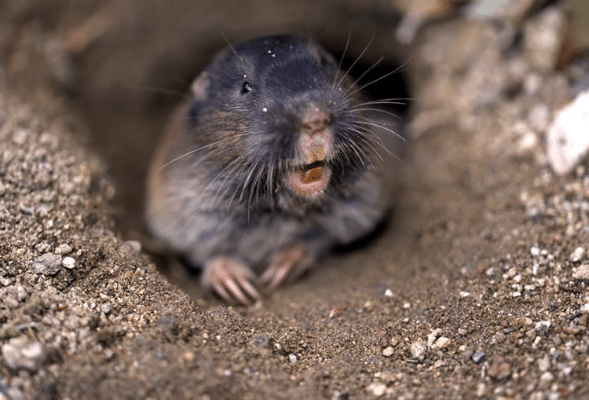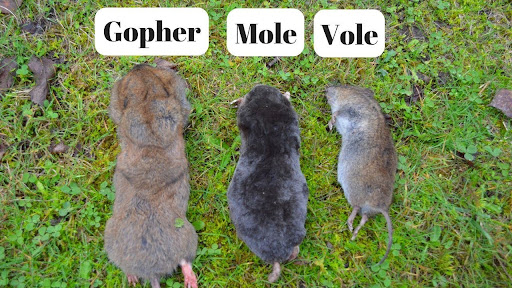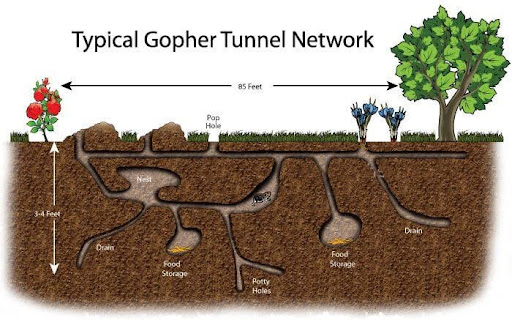Picture this: you’re enjoying a warm summer day, admiring your perfectly manicured lawn, when suddenly—oh no! You spot an unsightly mound of dirt disrupting your yard’s perfection. You may have a pest problem, but who’s the culprit? It could be moles, raccoons, gophers, or a burrowing critter. Most likely, gophers cause the mounds in your yard, and infestations of these pests can result in costly damage and annoying underground tunnels throughout your environment.
But before jumping to conclusions, it’s essential to understand what you’re dealing with. Gophers are more than just a nuisance—they’re a specific type of burrowing rodent that can wreak havoc on your landscape. To help you better understand these troublesome creatures, we’ve compiled a list of 10 facts about gophers and how to get rid of them. From their behavior to how to manage an infestation, this guide will give you the insights you need to identify these animals correctly and keep them off your land!
What is a Gopher? 5 Facts You Should Know

Image Source
Gophers are medium-sized, furry underground rodents known for their intricate tunnel systems. They’re found around North and Central America and are often referred to as pests due to their tendency to destroy yards and create mounds. Their full name is “pocket gopher” because of their fur-lined cheek pouches, or pockets, used to carry food and materials for nest-building purposes.
Here are 5 facts you should know about gophers, including their size, habitat, and what they look like:
1. Gophers are larger than mice, voles, and moles, reaching about 5–14 inches long with a 1–2 inch tail.

Image Source
Gophers are larger than mice, voles, and moles, but not the size of rats, at around 5–14 inches long, and have a tail that’s 1–2 inches long. They often weigh .5–1 pound, while some types of gophers reach almost 2.2 pounds in Central America.
2. Gophers look like moles, but are distinguished by visible eyes, ears, fur-lined cheek pouches, and larger size.
Gophers are commonly mistaken for moles or voles, but there are a few ways to identify them. While moles’ eyes and ears are tiny and hidden, gophers have visible eyes and ears. Moles don’t have cheek pouches like gophers, and they’re smaller with pointed snouts and paddle-like forefeet. On the other hand, Voles look more like small mice with short tails, rounder faces, and much smaller teeth than gophers’ long incisors. Gophers have round bodies with soft fur, thick whiskers, and four long, visible incisors. Their large incisors help them dig dirt, and their stout bodies are made for burrowing underground and making tunnels.
Gopher vs. Groundhog Tail: Gophers can also be mistaken for groundhogs, but their tails are a key difference. Gophers have short, hairless tails, while groundhogs have much longer, bushier tails that are easy to spot above ground. Below is a picture of a gopher’s tail (top) vs. a groundhog’s tail (bottom):

3. Gophers live underground in North and Central America.

Gophers live underground primarily underneath loose, sandy soil in North and Central America. They create homes in burrows with an intricate tunnel system using their long teeth. Gophers’ tunnels are used for various purposes, such as foraging, nesting, storing food, etc. Gopher tunnels can reach 200–2,000 square feet, with a nest and food storage area up to 6 feet deep. The mounds created by gophers are from dirt being pushed to the surface as they dig, destroying yards and causing costly damage. Gophers don’t live in groups, typically living solitary lives, and are highly territorial. These pests are active year-round and don’t hibernate, but they rarely emerge from their burrows, enjoying the comfort and safety of being underground.
4. Gophers live up to 3 years old.
Gophers can live up to 3 years, and females can have 1–3 litters per year, consisting of 5–6 young, depending on the region. After reaching 1 year old, young gophers will establish their homes in tunnels and begin reproducing. As mentioned previously, gophers prefer solitary lives inside their tunnel systems.
5. There are about 13 species of gophers in the US.
There are several types of gophers, with 13 species in the United States. Within the US, 3 main groups or genera are in this area, differentiated by the size of a gopher’s forefeet, claws, and incisors.
Here are the 3 main categories of gophers you’ll find in the United States:
- Eastern Pocket Gophers (Geomys) have two grooves on their upper large teeth. These pests also have large claws and feet and are brown to black. They range from 7 to 14 inches in length.
- Western Pock Gophers (Thomomys) live only in the Western Hemisphere and, depending on their region, range from 5 to 13 ½ inches in length. Their fur can be brown, black, or even almost white.
- Pappogeomys have large forefeet and claws, but only have one groove on each upper tooth. They range in size from 5 ½ to 7 ½ inches in length, with reddish brown to yellowish fur and an underfur that varies from white to yellow.
5 More Fun Facts About Gophers
Do you want to know more about these furry pests? Here are 5 more fun facts about gophers you may not have heard before:
1. Gophers commonly move backward in their tunnels, using their tails for easy navigation.
2. Gophers’ lips can close behind their four incisors, preventing dirt from entering their mouths while digging.
3. Gophers are very solitary and independent, often avoiding their own kind for peace of mind. However, on rare occasions, they may share their burrows with other critters, such as rabbits, skunks, lizards, and toads.
4. When cleaning their cheek pockets, gophers turn them inside out for a diligent wash.
5. Gophers have poor hearing and eyesight but a heightened sense of touch, which they depend upon for survival. With whiskers and a sensitive tail, gophers can properly feel out their surroundings and check for potential danger.
How to Get Rid of Gophers: 4 DIY Methods
If you’ve ever wondered, “What do gophers do?” the answer lies mostly underground. Gophers are expert diggers, creating elaborate tunnel systems that stretch hundreds of feet. These tunnels serve multiple purposes: for nesting, food storage, and protection from predators. But while these hidden networks are impressive, they can also cause significant damage. Gopher tunnels disrupt root systems, destroy gardens and crops, and compromise soil stability.
That’s why preventative measures are so essential. Once gophers establish their tunnel systems, removing them and repairing the damage becomes much harder. By acting early, you can stop gophers before they turn your yard or field into a maze of destruction. Here’s what you can do if you have a gopher problem at your property:
- Dig a Trench: One of the best ways to eliminate gophers is to dig a trench around the perimeter of your yard, which discourages these pests from digging new tunnels.
- Set Traps: If you don’t have many gophers, you can use a live trap to set them free in the wild or place a trap in your space that immediately kills these pests. However, this option isn’t very effective if you have several gophers.
- Use Liquid Repellents: Gopher repellents are strong-smelling substances that these pests prefer to avoid. If you decide to use liquid repellents, you must reapply them every few weeks.
- Try Fumigation Techniques: Smoke bombs are an effective way to exterminate these furry creatures or scare them off your premises. Start by covering the exits of burrows with soil or sod clumps, and then drop a smoke bomb into the gophers’ homes to eliminate them from your environment.
Read our blog abouthow to get rid of gophers for more in-depth strategies.
If you’ve tried every DIY method you can think of without success, it’s time to call a team of professionals for efficient gopher control services.
Hire Preventive for Expert Gopher Control Services
Are you tired of failed attempts to eliminate gophers in your yard? Stop buying traps or wasting time digging trenches, and partner with a professional gopher control team at Preventive Pest Control. We’ve been providing 5-star pest control in Orange County and pest control services in the Inland Empire for over 25 years, successfully eliminating gophers from yards around Southern California. Our team employs various strategies, including trapping, baiting, and an advanced carbon monoxide machine, to remove these rodents from your property and keep them away.
With affordable subscription plans and decades of experience under our belts, Preventive’s technicians promise efficient and ongoing gopher control solutions. Contact our team to experience a gopher-free living space and a yard void of mounds!

